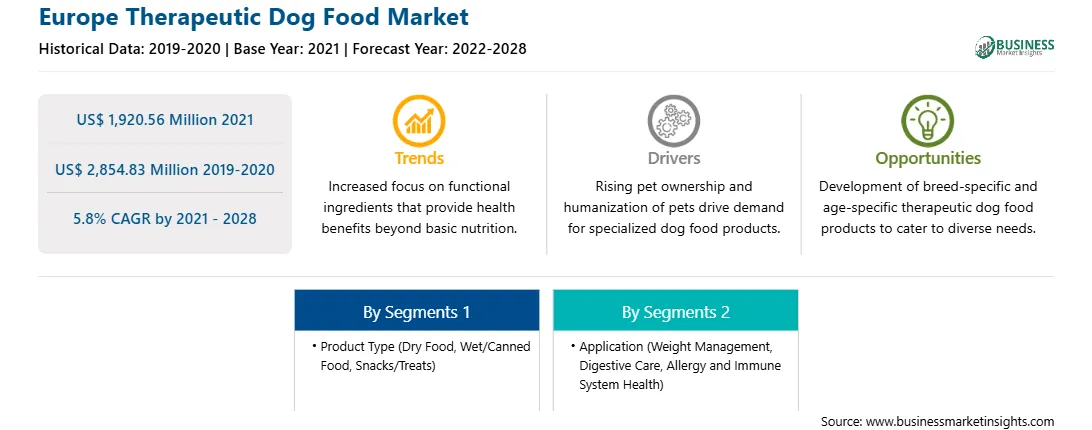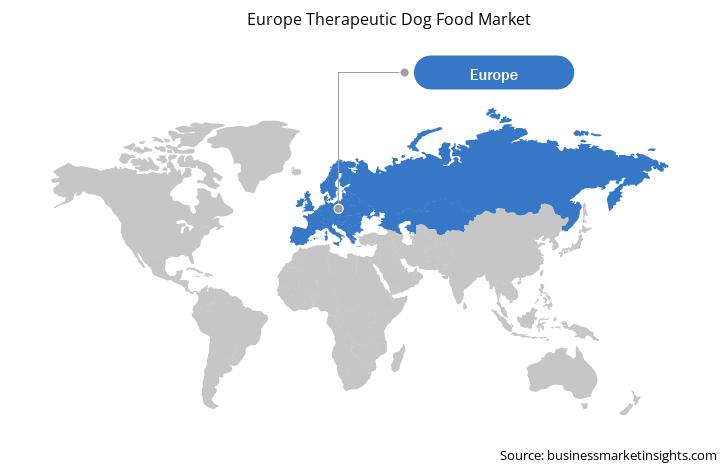A therapeutic diet is formulated to meet a pet's specific needs and is designed to combat or prevent diseases. The diet should comprise an optimum combination of carbohydrates, minerals, proteins, fats, vitamins, and water. Proper nutrition helps prevent infection among dogs and maintain their build, simultaneously allowing them to perform daily activities. Dog food manufacturers have been introducing products suitable for every stage of a dog’s life. Several of these products provide hypoallergenic nutrition, whereas other formulations are produced for controlling health conditions such as kidney and heart-related diseases, gastrointestinal issues, dental care, weight control, liver disease, and orthopedic conditions. Diets formulated to treat kidney disease are low in phosphorus and have moderate levels of proteins. A few therapeutic diets for skin disease contain proteins broken down into small pieces that are less likely to stimulate the immune response in dogs after consumption. Therefore, a therapeutic diet plays an important role in maintaining a dog’s health.
The countries in Europe are highly affected due to the COVID-19 pandemic. Italy and Spain have registered the maximum number of deaths due to COVIID-19. However, the animal health industry in European countries is minimally affected. The rapid increase in pet care spending in developed markets, such as the UK, Germany, and France, has also been accompanied by a surge in demand from newer and dynamic markets. In many countries, millennials are increasingly seeing pets as an alternative to children, driving pet adoption. As the COVID-19 crisis unfolds, the increase in pet care spending will change. At present, the short-term effects of the pandemic have been mixed, and many veterinary practices have remained closed for weeks due to containment measures. Also, the closure of adoption centers in a few countries slowed the pet ownership for some time in 2021. However, the market has not witnessed a sharp decline in the growth as many countries in the region have seen a rise in pet adoption after a few months.
With the new advancements and technologies, vendors can attract new customers and expand their footprints in emerging markets. This factor is likely to drive the Europe therapeutic dog food market. Similar to humans, animals too suffer from chronic diseases. Arthritis, chronic kidney disease, cancer, hepatitis and other liver diseases, skin allergies, and diabetes are commonly detected chronic diseases in pets. Cancer is increasingly widespread in companion and farm animals. According to the veterinary cancer society, the disease is a leading cause of death in 47% of dogs, especially dogs of age >10 years. Further, as per the Pet Cancer Facts and Figures, one in four dogs develop cancer in their lifetime. The Arthritis Foundation says ~20% of all adult dogs suffer from arthritis. Such growth in prevalence of chronic medical conditions has become a major concern among dog owners, which underlines the demand for proper care and diet. Thus, with the elevating prevalence of chronic medical conditions in dogs, pet food companies are focusing on producing advanced therapeutic and functional food products to help dog owners maintain the overall health of their pets.
Strategic insights for the Europe Therapeutic Dog Food provides data-driven analysis of the industry landscape, including current trends, key players, and regional nuances. These insights offer actionable recommendations, enabling readers to differentiate themselves from competitors by identifying untapped segments or developing unique value propositions. Leveraging data analytics, these insights help industry players anticipate the market shifts, whether investors, manufacturers, or other stakeholders. A future-oriented perspective is essential, helping stakeholders anticipate market shifts and position themselves for long-term success in this dynamic region. Ultimately, effective strategic insights empower readers to make informed decisions that drive profitability and achieve their business objectives within the market.

| Report Attribute | Details |
|---|---|
| Market size in 2021 | US$ 1,920.56 Million |
| Market Size by 2028 | US$ 2,854.83 Million |
| Global CAGR (2021 - 2028) | 5.8% |
| Historical Data | 2019-2020 |
| Forecast period | 2022-2028 |
| Segments Covered |
By Product Type
|
| Regions and Countries Covered | Europe
|
| Market leaders and key company profiles |
The geographic scope of the Europe Therapeutic Dog Food refers to the specific areas in which a business operates and competes. Understanding local distinctions, such as diverse consumer preferences (e.g., demand for specific plug types or battery backup durations), varying economic conditions, and regulatory environments, is crucial for tailoring strategies to specific markets. Businesses can expand their reach by identifying underserved areas or adapting their offerings to meet local demands. A clear market focus allows for more effective resource allocation, targeted marketing campaigns, and better positioning against local competitors, ultimately driving growth in those targeted areas.

The Europe Therapeutic Dog Food Market is valued at US$ 1,920.56 Million in 2021, it is projected to reach US$ 2,854.83 Million by 2028.
As per our report Europe Therapeutic Dog Food Market, the market size is valued at US$ 1,920.56 Million in 2021, projecting it to reach US$ 2,854.83 Million by 2028. This translates to a CAGR of approximately 5.8% during the forecast period.
The Europe Therapeutic Dog Food Market report typically cover these key segments-
The historic period, base year, and forecast period can vary slightly depending on the specific market research report. However, for the Europe Therapeutic Dog Food Market report:
The Europe Therapeutic Dog Food Market is populated by several key players, each contributing to its growth and innovation. Some of the major players include:
The Europe Therapeutic Dog Food Market report is valuable for diverse stakeholders, including:
Essentially, anyone involved in or considering involvement in the Europe Therapeutic Dog Food Market value chain can benefit from the information contained in a comprehensive market report.